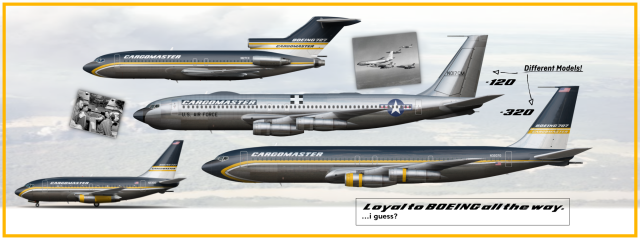
A Frankenstein 707, "Normal" Operations and the 1960s
- Owner: Marx (View all images and albums)
- Uploaded: Jan 05 2024 01:56 AM
- Views: 308
- Album Cargomaster
MED/Airplano21 for the templates.

The 1960's for the United States was quite tame, if we obviously don't consider the Vietnam War that was already raging on for 5 years at the start of the new decade. As a result, in January 1961, CargoMaster "leased" their first Boeing 707-120H, N017CM, to the USAF and the testing grounds of Nevada. What came next would eventually shape out the KC-135 program as the model was severely modified (and somehow kept it's original shape) to track the conditions of the plane when placed in military situations, with it's airframe being pushed to the limit. For a while, it was even given a refueling boom, as a matter of fact!
(N017CM, also known as "The Frankenstein", was eventually returned into regular CargoMaster service in 1969, becoming quite the popular plane among air force officials and Cargomaster employees/pilots. It was retired in 1991 from active service and preserved in the National Museum of the United States Air Force in 1999.)
As the jet age came, a lot of Cargomaster's older aircraft began to be phased out, such as the Convair 240 series, the Lockheed Constellation and the DC-4 series. A small number of DC-6 aircraft remained in the fleet for a small amount of time before their retirement was scheduled. However, the Convair series would eventually go down as the main source of a large-scale disaster.
On September 14th, 1964, CargoMaster flight 634 departed from Lindbergh Field, San Diego 7 minutes ahead of schedule. The plane, a Convair 340 registered as N90812, had been delivered to the Clifton's Cargo Masters company and was soon transferred to Cargomaster. However, it was one of the last planes in the fleet to still have the Lightning Bolt livery. The flight would make a technical stopover at Los Angeles before landing in San Jose. The first leg of the flight was uneventful and calm. With visibility low on approach to San Jose, the crew (Captain William D. Elrod, First Officer Daniel J. Madden and Second Officer Kobe H. Laurier) were soon given permission to land, however the plane and the three crew members faced spatial disorientation due to the harsh fog covering the city; as a result, the Convair greatly descended below the average approach altitude for San Jose. The altitude gauges seemed to be showing incorrect readings regarding the plane's position, but this can only be confirmed by the ATC Transcript.
[11:26:02] SJC ATC: Skipper six three four, cleared to land. Watch your altitude.
[11:26:05] CAP: Six three four, cleared to land.
[11:26:06] 2OF: Dont'cha think the attitude's quite off?
[11:26:08] 1OF: I can't see s*** here, Larry.
[11:26:11] 2OF: Oughta trust it.
[11:26:17] CAP: Finally arriving on time, eh?
[11:26:19] Unknown: *Sound of Laughter*
The crew soon noticed their error, and Elrod soon tried to rise the pitch of the airplane; but before it could gain any altitude, the Convair 340 collided against an early radio tower.
[11:26:27] 1OF: Gear's down.
[11:26:39] CAP: We're too low. Thing's faulty.
[11:26:43] 1OF: Let's get outta here.
[11:27:46] CAP: Increasing the throttles, pitchin' up now. Watch it..
[11:27:52] 2OF: Argh!
[Sound of Collision with Radio Tower]
Engine number 1 was caught by the radio tower, completely crippling it; the rest of the tower soon impacted the plane's left hand horizontal stabilizer, completely shearing it off while also taking a portion of the vertical stabilizer. Desperately, the crew contacted San Jose seconds after the collision.
[11:27:03] CAP: Tower! Tower, emergency!
[11:27:05] SJC ATC: Aircraft in emergency, please go ahead.
[11:27:04] Unknown: [Unintelligible] Number 1 is out.
[11:27:07] SJC ATC: Aircraft in emergency, say again.
[11:27:09] CAP: We've lost one of our engines, we can barely control it- F***.
[Sound of Vertical Stabilizer detaching after collision]
[11:27:12] 1OF: Don't pitch it up, we're rolling!
The plane would soon start rolling to it's left hand side, achieving an angle of 15 to 20 degrees before starting to pitch down. The plane would eventually rise at around 1,500ft before it's left wing uncontrollably dropped.
[11:27:41] CAP: Tower, this is 634, we're rolling below.
[11:27:43] Unknown: Kick it, Will!
[11:27:46] SJC ATC: Can you still make it back to San Jose, Skipper?
[11:27:47] 2OF: This is bad.
[Plane reaches 50 degrees of banking]
[11:27:49] CAP: Brace yourselves.
[11:27:51] Unknown: I'm so sorry, Pa.
[First impact, plane rolls over]
[11:27:54] 1OF: Get it up! Get it up!
[11:27:56] 2OF: Hell-
[Transcript is cut off, 11:27:56.5]
The Convair's wing impacted the rooftop of a restaurant, the drooping wing almost completely detaching from the airplane. It soon rolled on it's belly before crashing into a highway and into a series of low buildings before completely disintegrating in flames. The crash eventually caused the three pilots to perish, along with one death and nine injuries on the ground, totalling 4 casualties and 9 injuries. The crash would be known as the 1964 San Jose Air Incident, being the first major accident for CargoMaster in general.
The cause was eventually ruled out as a Mechanical and Pilot Error on the Convair 340 and ATC Error. After this incident, Jerry Clifton, now an elderly veteran, resigned as the CEO of CargoMaster shortly after, but still attempted to help with the crash's investigation and the company's management in general.
After the accident, CargoMaster sought to retire it's piston-engined aircraft; the replacement for smaller aircraft arrived in 1966 as the Boeing 727-100H, two years after the crash, and soon after the Boeing 737-100H. Evidently, CargoMaster had strayed away from Douglas and consequently became closer to Boeing, which turned into it's primary contractor for the company's aircraft. the Douglas DC-8 was almost acquired, but the purchase was eventually declined in favor of the Boeing 707-320, which became the 707-320H.
Hello! this was quite rushed, and i'm very sorry for it. In the future, i will make sure to divide accidents into their own respective images, going more into detail as to why that specific plane crashed while detailling other stuff. In the meantime, I am accepting feedback! See you soon, happy late new year! --Marx ![]()

 Sign In
Sign In Create Account
Create Account











amazing job